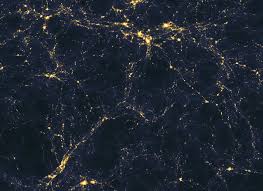The Largest Structure in the Universe
Current Affairs International IssuesPosted by newadmin on 2025-02-10 08:51:21 |
Share: Facebook | Twitter | Whatsapp | Linkedin Visits: 19

Recent astronomical research has unveiled Quipu, the largest known structure in the universe. Named after an ancient Incan recording system, Quipu possesses an extraordinary mass of 200 quadrillion solar masses and extends over 400 megaparsecs, or more than 1.3 billion light-years. This discovery holds immense significance for understanding cosmic evolution and refining existing cosmological models.
Superstructures, such as Quipu, are enormous formations composed of galaxy clusters and superclusters. These colossal structures play a crucial role in shaping the universe’s evolution. Alongside four other identified superstructures, Quipu contains 45% of galaxy clusters, 30% of galaxies, and 25% of the universe’s matter while occupying 13% of the observable volume. Its vast mass challenges current cosmological theories and calls for a deeper investigation into the formation and distribution of matter in the universe.
The discovery of Quipu was made possible through the analysis of X-ray galaxy clusters in the Cosmic Large-Scale Structure in X-rays (CLASSIX) Cluster Survey. X-ray emissions from hot intracluster gas serve as key indicators of mass concentration, enabling astronomers to identify the densest regions of matter and map these massive superstructures with remarkable accuracy.
Quipu’s existence provides crucial insights into the processes governing galaxy evolution and helps refine critical cosmological parameters. The gravitational effects of this enormous superstructure alter the Cosmic Microwave Background (CMB) and impact measurements of the Hubble constant, adding complexity to our understanding of cosmic expansion and the universe’s early conditions. These gravitational influences introduce distortions in astronomical observations through large-scale gravitational lensing, affecting the accuracy of key cosmological measurements. Understanding these distortions is essential for improving observational techniques and ensuring precise data interpretation.
Simulations based on the Lambda Cold Dark Matter (Lambda CDM) model have successfully produced superstructures resembling Quipu, reinforcing the model’s validity in explaining the large-scale structure of the universe. However, continued exploration and study of such massive formations are necessary to deepen our comprehension of cosmic evolution and refine existing theoretical frameworks. The discovery of Quipu marks a significant milestone in astronomy, opening new avenues for research into the fundamental forces shaping the cosmos.
Search
Categories
Recent News
- Bihar's Top Cop Opens Doors to Public Grievances
- Hyderabad Gears Up for Presidential Visit: Traffic Diversions Announced
- Hyderabad Expressway Gridlock: Three-Car Pile-Up Causes Chaos
- Hyderabad Gears Up: Security Measures for Presidential Visit
- Hyderabad's Rs 23 Lakh Scam: Fake Trading App Dupes Investors
- Pinkathon Hyderabad: Empowering Women, One Step at a Time
- Hyderabad's Drug Supply Chain Unravelled
- Hyderabad's New Year's Eve: Safety Meets Celebration
Popular News
- Navigating IPO Market Dynamics Amid Volatility and Regulatory Changes
- Innovative Green Practices and Environmental Initiative
- Massive Worldwide Microsoft Outage Disrupts Multiple Sectors
- తెలుగుదేశం పార్టీ - పేదరికాన్ని నిర్మూలించడంలో వాగ్దానం
- Universities Embrace Remote Learning Technologies Amidst Ongoing Pandemic